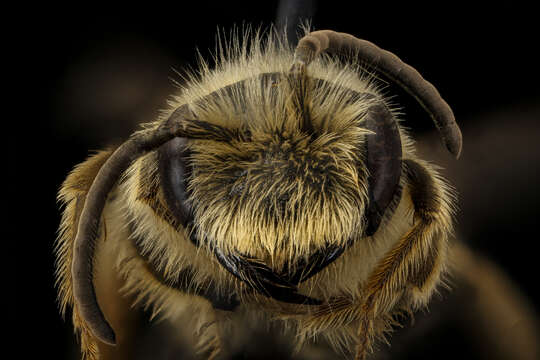Andrena obscuripennis, male, face, Clarke, GA_2021-06-08-14.06.44 ZS PMax UDR

Description:
The male Bear Andrena. Andrena obscuripennis. All bee species have males and females. Male bees are different from humans in that they are haploid not diploid (it would appear there are other differences, but those are not the interest at hand). Functionally that means that they are produced sans sexual reproduction and any female (bumble bee workers too!) can just pump out and egg and it will become a male (I presume this means that all that molecular material from said female is basically copied over to the male). While this is standard Hymenoptera dogma, what I can't seem to find out is why then do males often look so different from females? Often quite radically so. How does having only your Mom's chromosomes make you (the boy bee) look like a boy bee? Having these musings floating around makes me wonder if the world would be a better place if human males were haploid instead of diploid, did no real work to support a family, drank nectar all day, and whose sole purpose was to mate? Sadly, dear Techniterns, no one filled out the Bee Picture log so I can't tell who took this picture. ~~~~~~~~~~{{{{{{0}}}}}}~~~~~~~~~~ All photographs are public domain, feel free to download and use as you wish. Photography Information: Canon Mark II 5D, Zerene Stacker, Stackshot Sled, 65mm Canon MP-E 1-5X macro lens, Twin Macro Flash in Styrofoam Cooler, F5.0, ISO 100, Shutter Speed 200 We Are Made One with What We Touch and See We are resolved into the supreme air, We are made one with what we touch and see, With our heart's blood each crimson sun is fair, With our young lives each spring impassioned tree Flames into green, the wildest beasts that range The moor our kinsmen are, all life is one, and all is change. - Oscar Wilde You can also follow us on Instagram - account = USGSBIML Want some Useful Links to the Techniques We Use? Well now here you go Citizen: Best over all technical resource for photo stacking: www.extreme-macro.co.uk/ Art Photo Book: Bees: An Up-Close Look at Pollinators Around the World: www.amazon.com/Bees-Up-Close-Pollinators-Around-World/dp/... Free Field Guide to Bee Genera of Maryland: bio2.elmira.edu/fieldbio/beesofmarylandbookversion1.pdf Basic USGSBIML set up: www.youtube.com/watch?v=S-_yvIsucOY USGSBIML Photoshopping Technique: Note that we now have added using the burn tool at 50% opacity set to shadows to clean up the halos that bleed into the black background from "hot" color sections of the picture. www.youtube.com/watch?v=Bdmx_8zqvN4 Bees of Maryland Organized by Taxa with information on each Genus www.flickr.com/photos/usgsbiml/collections PDF of Basic USGSBIML Photography Set Up: Google Hangout Demonstration of Techniques: plus.google.com/events/c5569losvskrv2nu606ltof8odo or www.youtube.com/watch?v=4c15neFttoU Excellent Technical Form on Stacking: www.photomacrography.net/ Contact information: Sam Droege sdroege@usgs.gov 301 497 5840
Included On The Following Pages:
- Life (creatures)
- Cellular (cellular organisms)
- Eukaryota (eukaryotes)
- Opisthokonta (opisthokonts)
- Metazoa (Animal)
- Bilateria
- Protostomia (protostomes)
- Ecdysozoa (ecdysozoans)
- Arthropoda (arthropods)
- Pancrustacea
- Hexapoda (hexapods)
- Insecta (insects)
- Pterygota (winged insects)
- Neoptera (neopteran)
- Endopterygota (endopterygotes)
- Hymenoptera (wasps, bees, and ants)
- Apocrita (wasp)
- Aculeata
- Apoidea (bees & apoid Wasps)
- Anthophila (bee)
- Andrenidae (mining bees)
- Andreninae (Mining Bees)
- Andrenini
- Andrena (digger bees)
- Andrena obscuripennis (Dusky-winged Andrena)
This image is not featured in any collections.
Source Information
- license
- cc-publicdomain
- copyright
- USGS Bee Inventory and Monitoring Lab
- photographer
- USGS Bee Inventory and Monitoring Lab
- original
- original media file
- visit source
- partner site
- USGS Bee Inventory and Monitoring Lab
- ID


